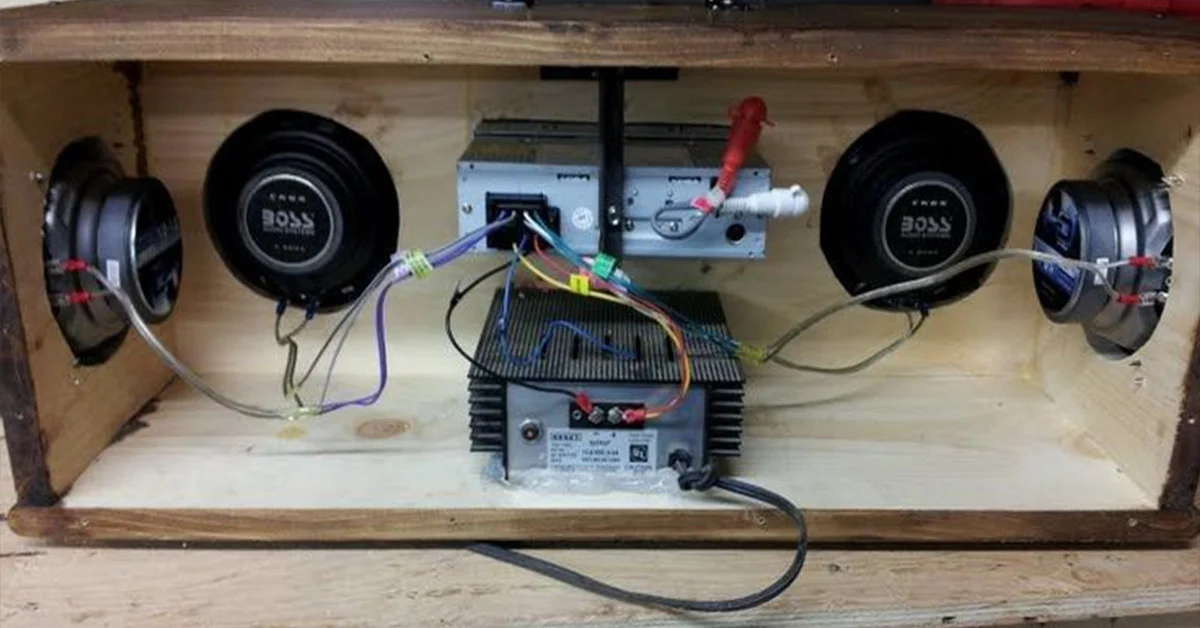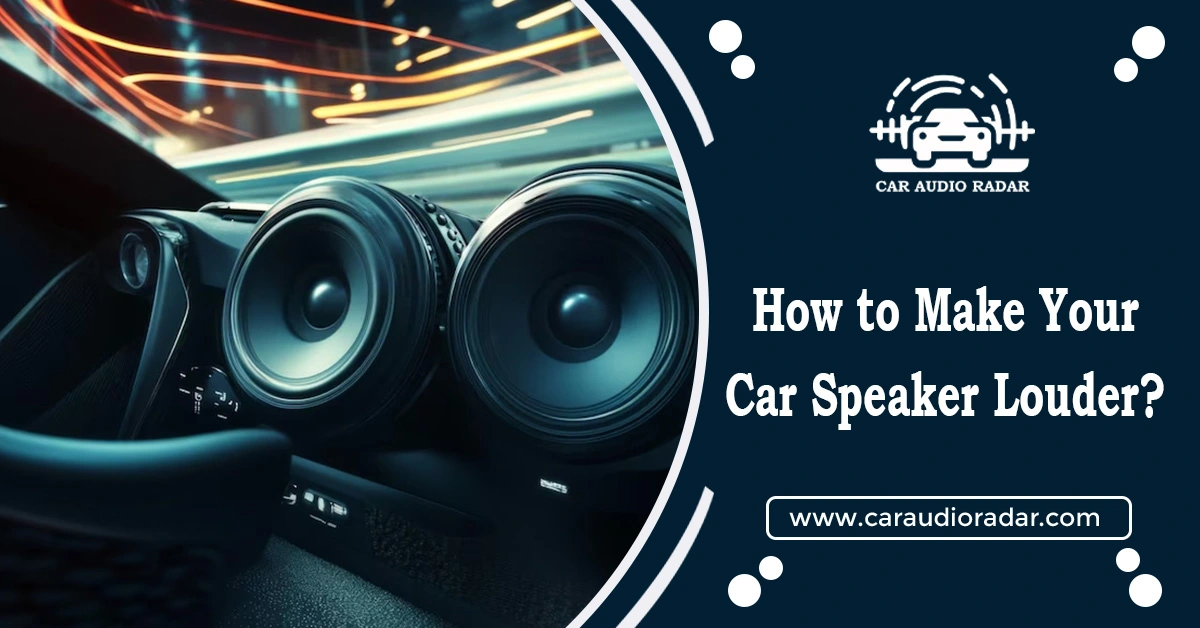
Jump to
A Complete Guide: How to set up a 8 Speaker Car Audio System

Set up a 8 speaker car audio system can transform your driving experience with immersive sound quality. It’s important to pick the right speakers and put them in the best spots, considering if you’re using sets of speakers or aiming for a surround sound setup. Setting up many speakers needs careful thinking and doing things in the right order.
It would help to consider how much power the speakers can handle, their sensitivity, and their electrical resistance. Following some important steps, you can make a special sound system for your car that gives you clear sound and strong bass. In this article, we will guide you through setting up an 8-speaker car audio system for the ultimate in-car entertainment.
How to set up a 8-Speaker Car Audio System Effectively?
Step 1:Planning Your System
Planning is really important for a successful setup. You must consider where each speaker will go and what kind of speaker will work best there. Here are the first things you need to do: please consider the options carefully.
Decide Where to Put the Speakers
Your car’s design will decide where you can put speakers. You must find spots with enough space to fit the speakers without blocking other car parts, like windows or airbags. Common spots include the front and back doors, the back shelf, and the front pillars for tweeter.
Choose the Right Speakers for Your Car
Not all car speakers are the same, so you have to pick ones that are good quality and fit your car. Look at how much power they can handle, their sensitivity, and their resistance. You also have to decide if you want coaxial speakers (with multiple driver types on one frame) or component speakers (individual drivers that you can mount separately), keeping in mind how four speakers might be arranged for optimal sound.
Step 2: Installing the Head Unit
The head unit is like the brain of your car’s sound system. It’s where you put CDs, plug-in devices with AUX or USB, and adjust the sound.
Remove the Old Head Unit
First, disconnect the car battery to stay safe. Then, carefully remove the old head unit by unscrewing any screws or bolts and unplugging the wires and antennas from the back.
Connect the New Head Unit
Ensure the new head unit’s wires match those in your car. Connect the right cables (usually color-coded) by stripping the ends and using connectors or soldering them together. Once connected, slide the new head unit in place and secure it. Reconnect the car battery, turn on the head unit, and you should hear a sound if everything’s connected right.
Step 3: Connecting the Speakers
You’ll need to connect the speakers to the head unit using wires.
Put Wires in the Car
Start from the head unit and run wires to each speaker’s location. Follow the same paths as other wires in your car, and make sure to keep them away from power wires. Secure the speaker wires as you go.
Connect Each Speaker to the Head Unit
At each speaker spot, strip the ends of the wires and connect them to the right terminals on the speaker. Make sure to match positive with positive and negative with negative to keep everything in sync and make it work efficiently. Cover the connections with electrical tape or heat shrink tubing to protect them.
Step 4: Making the Sound Louder and Better
An amplifier can make your audio system sound much better by strengthening the signal to the speakers.
Put in an Amplifier for Better Sound
Pick a good amplifier that matches how much power your speakers need, especially if running two sets of speakers for a balanced sound. Put it in a safe place that won’t get wet or hot. Connect power and ground cables to the amplifier, ensuring they have the right fuses and are properly connected.
Use good RCA patch cables to connect the head unit to the amplifier to ensure a clean, strong signal for two sets of speakers.
Step 5: Checking and Fixing
Once everything’s hooked up, it’s time to test the system and ensure it works its best.
Check Each Speaker
Turn on your system and play some music. Go to each speaker and make sure it’s making sound. Also, check if your head unit’s balance and fader settings are working right.
Adjust the Sound
Use the settings on your head unit, like the equalizer and crossover, to make the sound the way you want it. If your amplifier has extra controls, like gain and bass boost, you can use those to tweak the sound even more.
What are the benefits of having an 8-speaker setup in your car?
Better Sound Quality and Clearer Sound
Having 8-speakers gives you good sound quality with clear tones, making your music sound like you’re at a big concert. When sound comes from many speakers, it feels like the music surrounds you.
Louder Sound
With 8-speakers in your car, you can increase the volume without losing quality. Whether listening to calm tunes or energetic music, you’ll get a strong sound filling your car, especially if you use a system designed to play louder.
Make it Your Own
Having 8 speakers lets you customize your sound setup. You can adjust the balance, fade, and equalization to make the sound fit your style, creating a unique sound experience just for you with two sets of speakers.
How to set up a 4-channel AMP for an 8-Speaker System?
Understanding What Each Channel Does
Each of the 4 channels on the amp has a job to power the speakers. Match each group of speakers to one channel based on where they are in the car to make sure the sound is spread out evenly.
Using Bridging to Get More Power
Bridging channels on the amp means combining the power of two channels to run one speaker or two speakers for a more powerful output. This helps to get the most power to your speakers without overloading the amp.
Changing Frequency Settings for Better Sound
Adjusting the frequency settings on your amp can make your 8-speaker system sound even better. Play around with crossover points and frequency settings to find the best sound for your speakers.
Common Troubleshooting Techniques
Dealing with Sound Distortions
If you hear weird sounds in your 8-speaker system, check the wires, where you put the speakers, and the settings on your amplifier. Fixing these issues can get rid of the strange sounds.
Troubleshooting Wiring and Connection Issues
Inspect the wiring connections and terminals for any loose connections or damaged wires that may be causing audio disruptions. Properly secure the wiring and ensure a clean and stable connection between the speakers, amplifier, and car stereo system.
Checking for Compatibility with Factory Speakers
If integrating aftermarket speakers into your car audio system, ensure compatibility with your car’s factory components. Check the impedance ratings, power handling capabilities, and physical dimensions of the new speakers to avoid conflicts with the existing setup.
Conclusion
Now that your 8-speaker car sound system is installed, you can start driving and enjoy great music on the road. Remember, how well you set it up affects how good it sounds. Take your time, check everything twice, and if you’re not sure about something, it’s okay to ask a professional for help. We give everything you need for set up a 8 speaker car audio system. Hopefulyl you can install with ease.
Frequently Asked Questions(FAQs)
A 4-channel amp is a device that makes your car speakers louder. It can power four or pairs of speakers in your car’s sound system. It is essential for creating a well-balanced sound with per channel for different speakers.
To make your car speakers sound good, install them correctly, ensure the speakers’ resistance matches the amplifiers, and adjust settings for the best sound.
Tweeters are tiny speakers made for making high-pitched sounds in a car’s audio system. They’re crucial for making voices and high notes in music sound clear and sharp.
To install an 8-speaker car audio system, connect all speakers to a suitable 4-channel amplifier with four speakers per channel, ensure the wiring is correct for each speaker, and adjust settings for the best performance.
The main gap between 8-ohm and 4-ohm speakers is their impedance, which is their electrical resistance. 4-ohm speakers are often used in car audio setups because they use power more efficiently and work well with most amplifiers.
Yes, you can integrate subwoofer into an 8 speaker car audio system to enhance the bass performance and overall audio experience. Make sure to match sub woofer impedance and power requirements with your setup.
Cooper Katzeel
Car Enthusiast
Cooper Katzel, a dedicated car enthusiast, delves into the world of automobiles and audio systems. With a deep interest in cars and a focus on superior sound, Cooper’s expertise traverses the spectrum. His journey is a delightful exploration of automotive wonders and the world of car speakers. Cooper’s passion and technical know-how make him a trusted advisor for car enthusiasts.
Follow On Instagram
Recent Posts
- All Post
- Blog
- Car Speaker
- Car Subwoofer
- Pro Tips & Guides
- Back
- Speaker Wire



Dream Life in Paris
Questions explained agreeable preferred strangers too him her son. Set put shyness offices his females him distant.


